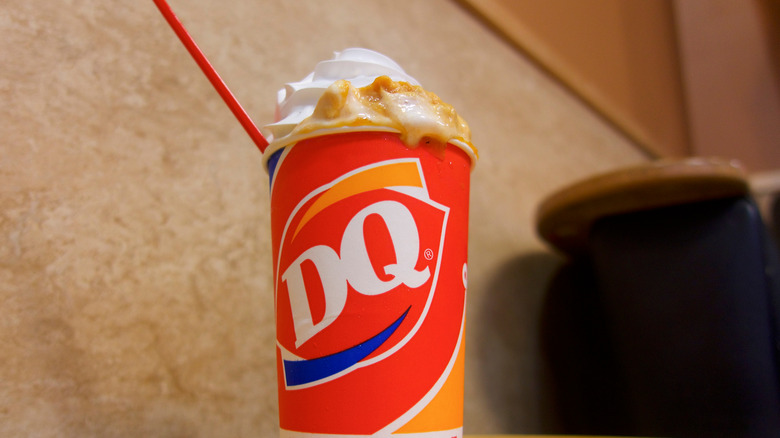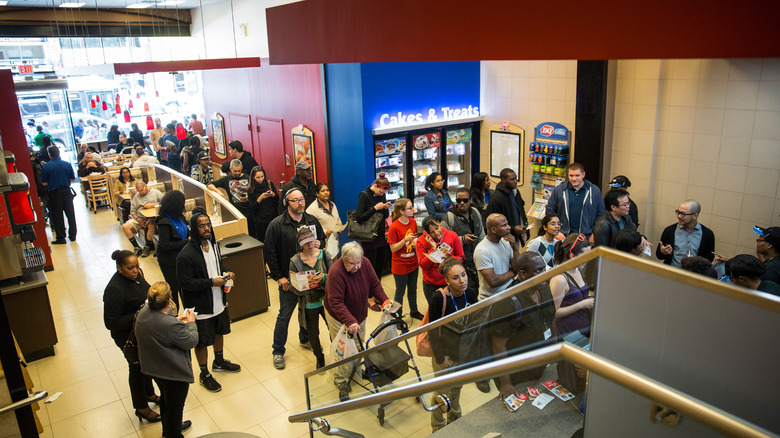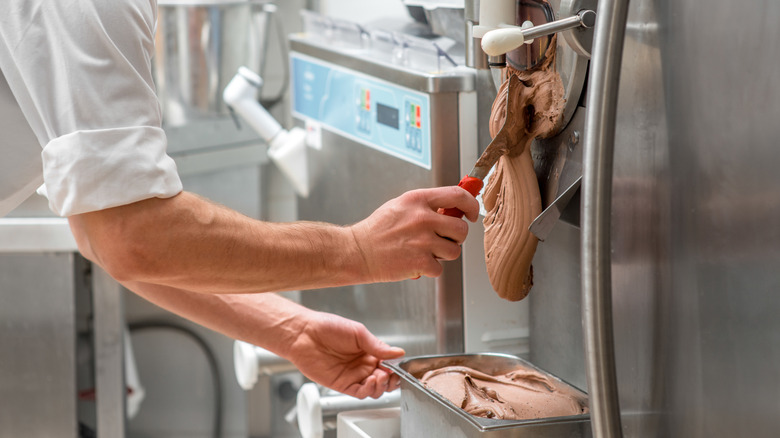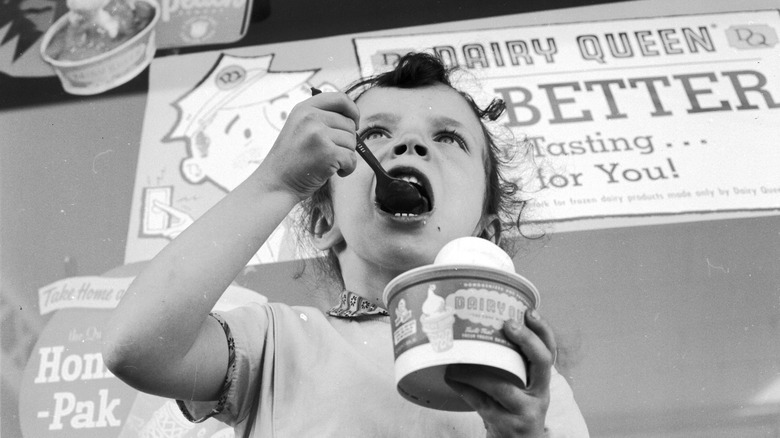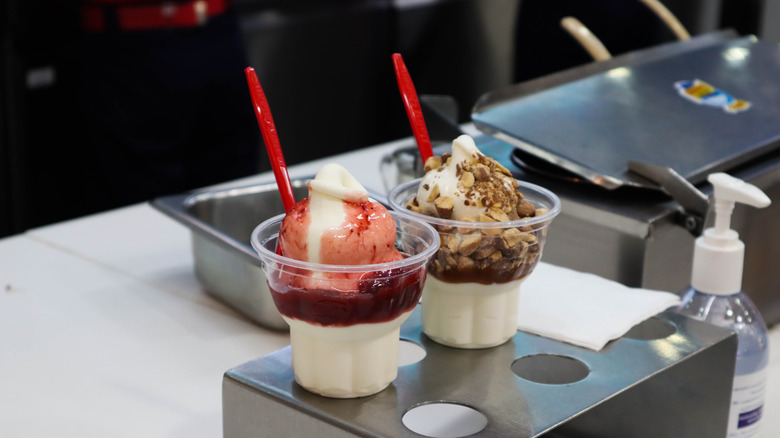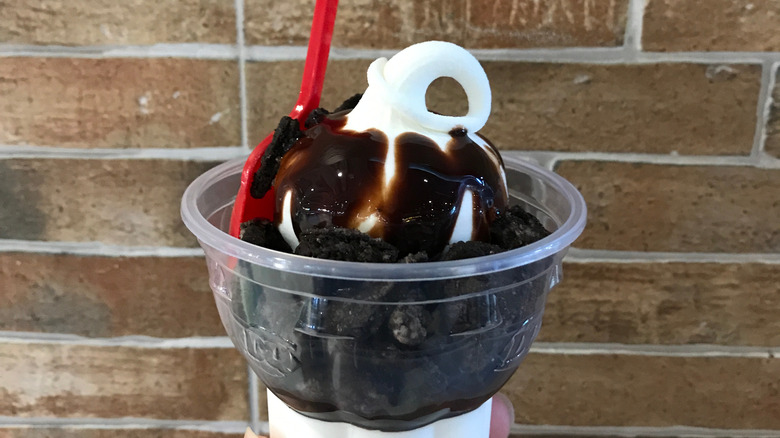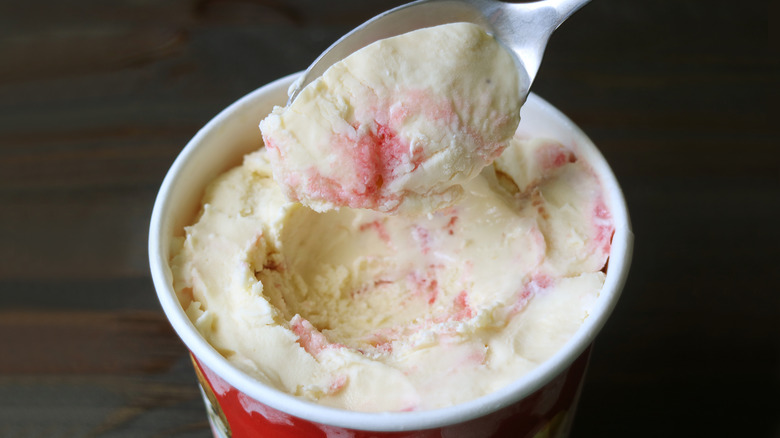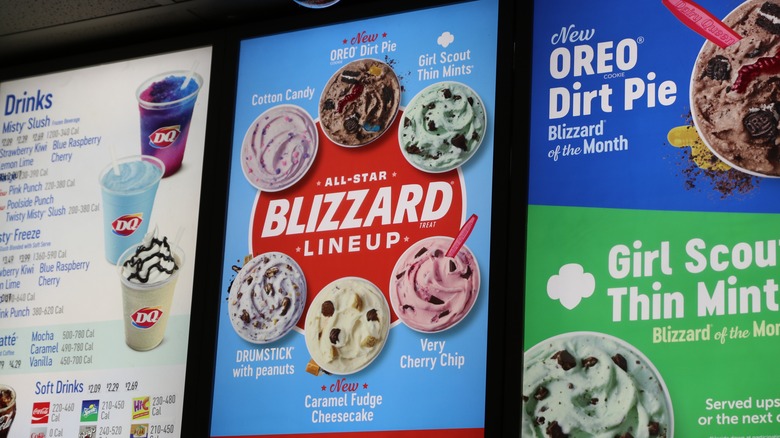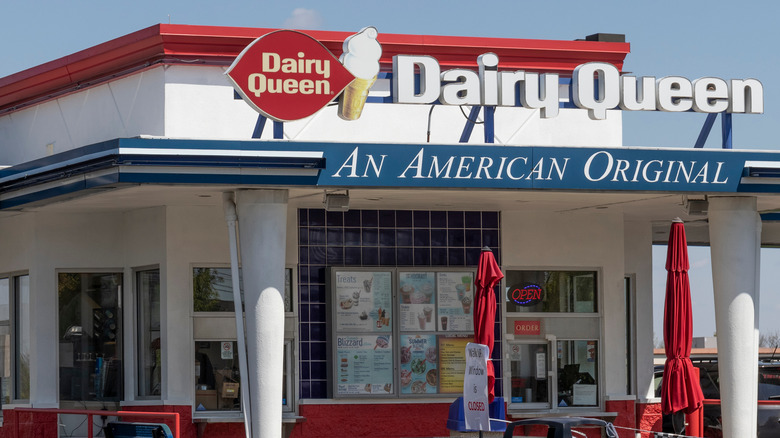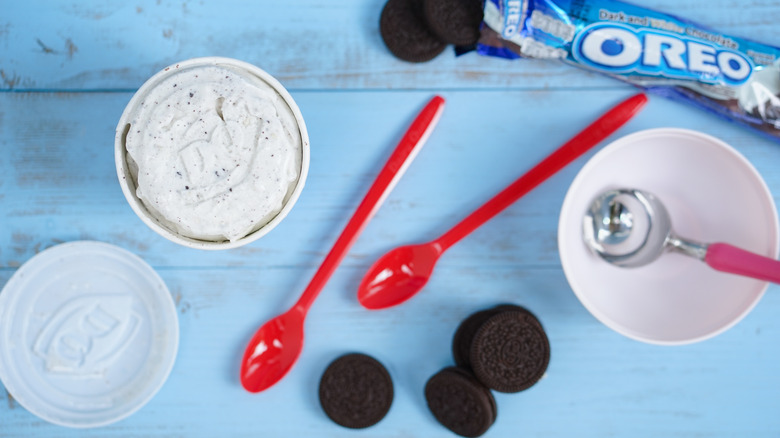The First Ever Dairy Queen And What It Was Like To Eat There
Dairy Queen has been around for a while. The fast food desert joint with the distinctive curlicue-topped soft serve celebrated the 75th anniversary of its first Texas locations last year. The company today boasts locations in over 20 countries, as well as an expansive menu of frozen treats like its famous Blizzard, alongside fast food staples like burgers and fries. The company was born in the same post-World War II fast food franchise boom that made McDonald's, In-N-Out, and KFC the globe-straddling titans they are today and after almost 60 years of healthy expansion, it was bought by Berkshire Hathaway. Now that it's been part of Warren Buffet's financial empire, it's probably safe to assume that Dairy Queen will be with us for the foreseeable future.
But the restaurant's history goes back to a single location with a limited menu in a humble Illinois suburb. Before Buffet, Blizzards, and bemusing technicalities about what counts as ice cream, Dairy Queen was a local ice cream parlor serving the families and neighbors of steelworkers and corrections officers. The original suite housing that parlor is now a recognized historical site, although no longer a Dairy Queen location. While we can't take you back for a sundae there, we can tell you what you were store for at what was then the one and only Dairy Queen, in 1940 Joliet, Illinois.
It was next to a giant steel mill
The first Dairy Queen was founded in Joliet, Illinois; less than 50 miles outside Chicago with the Joliet Iron and Steel Works among the residents' major employers. By 1921, even before the mill had "steel" in its name, geographer Douglas Clay Ridgely wrote its blast furnaces could output 2,000 tons of pig iron daily. Now a park, the Joliet Iron Works occupies 52 acres of land with much of its original foundation intact, albeit crumbling. When this expanse of modern Stonehenge was in business, it was barely a 10 minute walk north from where John Fremont McCullough, his son Alex, and their business partner Sherb Noble opened up their first location under the Dairy Queen name.
Coke, the coal derivative used in steel smelting and production, produces hydrogen sulfide as a byproduct. The colorless gas even today is notorious for producing a "rotten eggs" smell in communities surrounding steel production plants. As we'll see later, the first Dairy Queen didn't have much in the way of parking so most customers entered by foot traffic, meaning that the very first Dairy Queen with churning freezer-dispensers full of milk and sugar would have been a refuge from the sulfuric odors coming off the steel plant.
You pretty much had to walk in
Sherwood "Sherb" Noble, Dairy Queen's co-founder had previously tested the McCullough's soft serve in his own ice cream parlor in nearby Kankakee, Illinois. When time came to open the first Dairy Queen in 1940, he found its storefront at 501 North Chicago Street in Joliet, in a building that was already 45 years old. Situated in Joliet's downtown, and accessible to travelers along Route 66, Dairy Queen's birthplace was characterized by Noble himself as "strictly a walk-in type store... with very little parking" (via Kankakee's Daily Journal).
The company quickly adopted different form factors, with the first Kankakee location opening in 1947, serving through a walk-up window. Today Dairy Queen locations come in several different iterations. The company acquired smoothie chain Orange Julius in 1987, making hybrid DQ/Orange Julius locations common in shopping mall food courts. Franchisees were introduced to the "DQ Grill & Chill" in 2002, a restaurant concept and floorplan including dine-in booths, table service, a drive-thru window, and an interior and signage design that emphasized that Dairy Queen now offered entrees alongside its desserts.
We can only speculate, but with Noble's comment that the first Dairy Queen was situated "between two funeral parlors," we may have a piece of what motivated its proprietors to expand to other locations as quickly as they did.
It teased the public two years before its opening with an all-you-can-eat promotion
Sherb Noble was already in the ice cream business before the McCullough's approached him with their new soft serve creation. A graduate of Iowa State College's vocational dairy program, Noble operated his own self-titled Kankakee ice cream store alongside two others, working with the McCollough's as his suppliers. Ice cream at the time was all hard packed and tended to be harder in consistency than what you'll find in the grocery freezer aisle today, familiar to anyone who's tried making it at home.
In 1938 John Fremont McCullough introduced Noble to the new invention he and his son had developed: an ice cream mixture that used a lower fat content that made it come out softer, at a slightly higher temperature, and hopefully with a more flavorful result. As an exercise in market testing, the new "soft serve" was sold to customers at Noble's store (simply called "Sherb's") at 10 cents a pop, unlimited. The "all-you-can-eat" promotion took place on August 4th, 1938. With Chicago area summers reaching the low triple-digits at their peak even then, the creamy, sweet, and cool concoction was an immediate hit, and the 1,600-serving stock was reportedly depleted within two hours.
Soft serve was already its main product
After the smashing success of the all-you-can-eat promotion at Sherb's, the McCullough's eventually hit upon the freezer/dispenser machine they needed to stream Dairy Queen soft serve directly into the cup or cone in its famous swirl. The soft serve that flew out of Noble's hands in 1938 was all hand-scooped. They approached dairy machine manufacturers for help designing and producing the device they needed, but the first two companies that the McCullough's approached rebuffed them. It was one Harry M. Oltz of Hammond, Indiana who came to the McCullough's rescue when they found his ad in the Chicago Tribune for his patented ice cream-dispensing freezer.
When the first Dairy Queen launched in 1940, the McCullough's and Sherb Noble had waited almost two years for a way to bring their soft serve to market, and they focused solely on their flagship product. Dairy Queen locations today have an ever-evolving selection of shakes, smoothies, burgers, and even the occasional coffee drink with a name that some critics have said sounds like a racial slur. But in 1940, the McCullough's, Noble, and Oltz cut the proverbial ribbon on a dessert shop with a simple menu of cones, cups, sundaes, and quarts to take home, all containing exclusively their brand of soft serve.
It had cones and cups in two sizes
The ice cream cone had almost 40 years of market development when Dairy Queen launched, so it's no surprise that cones of soft serve graced the first menu the company ever posted, alongside cups (then called dishes) and sundaes. The 501 North Chicago Street location offered cones and dishes in two sizes, a five cent and a 10 cent option, and every cone after the second went for only a penny on opening day. The U.S. Bureau of Labor Statistics' Consumer Price Index inflation calculator would put those prices equivalent to $1.07 and $2.14 in today's money, which isn't far off from how much an equivalent DQ cone would set you back today. Although as the old saying goes in the franchise food world: Prices and participation may vary.
Today, the plain dish of soft serve no longer graces Dairy Queen's menu, although ordering a sundae without any topping or sauce would be an incredibly doable — albeit incredibly boring – menu hack. Meanwhile, cones now come in four sizes: Kid's, Small, Medium, and Large, which is in-line with the documented tendency for fast food portion sizes to grow over time.
Sundaes were already an option
By 1940, the ice cream sundae had already been around for over 50 years. At its root, a sundae is simply sauce-drizzled ice cream, meaning that any ice cream parlor stocked to industry standards already had all the ingredients needed for the upgraded frozen dessert by 1940. And Dairy Queen was no different, offering "a most delicious sundae" at an eight cent and a 12 cent price point.
The contemporary Dairy Queen menu offers simple sundaes in six varieties: chocolate, hot fudge, caramel, peanut butter, strawberry, and pineapple varieties that include chunks of real fruit suspended in syrup. It is unknown how many of those varieties were already on offer when Dairy Queen first opened its doors, but we do know that it did not take long for the soft serve giant to expand its offerings as it expanded its footprint. By 1960 Dairy Queen franchises were experimenting with unique combinations of flavors for its sundaes that became mainstays of the brand's marketing, such as the "Jack & Jill Sundae" which included a pour of hot fudge on one side and marshmallow-flavored syrup on the other, creating a striking two-tone dessert that had a revival just last year when an employee shared it on TikTok, unofficially canonizing it on the DQ secret menu.
You could buy the soft serve by the quart to take home
As we spoke of before, Dairy Queen's soft serve required special equipment to be dispensed at its preferred temperature and texture. Soft serve owes its unique texture to the air distributed throughout its volume in the mixing process, making it essentially whipped ice cream. With that air comes heat; soft serve is around 10 degrees warmer than traditional ice cream. With all these conditions, you'd think the first Dairy Queen would capitalize on its uniqueness by making the Joliet store the only place to acquire that soft serve, fresh from the dispenser since a home ice box would likely turn the soft serve into standard hard-packed ice cream. But no, the first Diary Queen location advertised that you could buy its soft serve by the quart at 35 cents per tub.
Today, Dairy Queen locations frequently have a freezer of take-home products, including quarts of soft serve. And with the advent of the Dilly Bar and Buster Bar, Dairy Queen's proprietary treats of coated soft serve on a stick, its to-go selection has only ever expanded. The Moorhead Dairy Queen in Moorhead, Minnesota which still operates under the same franchise contract its owners signed in 1949, has even furnished its own expansive menu of unique take-home novelties made in-house.
Shakes and malts weren't yet on the menu
With the softness of Dairy Queen's product, you would think that a mixture of milk or soda to make a shake, malt, or float would be a no-brainer, but the original Dairy Queen had no such items on its original menu. Everything that came out of that original Joliet location had to be licked off a cone or spoon. While ice cream-slinging soda fountains were ubiquitous across the U.S. at the time, making shakes, malts, and floats– standard offerings even at the local drug store — Dairy Queen put off introducing any ice cream-derived drinks to its menu. It took nine years for Dairy Queen to offer shakes and malts to its customers.
Today, the Dairy Queen drinks menu is a cavalcade of options from Orange Julius smoothies, to the ICEE-esque Misty Freeze and Slush, to the uncomfortably-named MooLattes. And of course, there is an ever-evolving roster of shakes and malts. Chocolate, vanilla, and strawberry are perennial options, but the chain is still introducing new flavors such as last year's S'mores shake. Meanwhile, Dairy Queen's competition in the fast food world has evolved in kind, with various burger joints putting their own eclectic shakes on the menu as Dairy Queen has come to serve burgers and fries.
Dairy Queen had competition from the start
The McCullough's creation of soft serve was a revelation for them, but not for the world. The invention of soft serve was less like a proverbial "lightbulb moment" and more like a gold rush, with various ice cream purveyors across the U.S. racing to find a way to reliably and consistently produce soft serve ice cream at scale. Meet Athanassios Karvelas, better known as Tom Carvel. The Greek-born expat was selling ice cream from a refrigerated truck when in 1934 as the legend goes, a flat tire on a blistering Memorial Day weekend forced him to desperately sell his melting stock to minimize his losses. The semi-melted soft ice cream was a hit, and Carvel created a new recipe and a new pumping machine for an ice cream that could be kept cold but not frozen, and served with the same texture as the semi-solid ice cream that made his near-disaster into a sterling success.
Carvel's own soft serve empire was already expanding by the time Noble and the McCullough's launched Dairy Queen, but his operations were exclusive to the East Coast at the time. In 1947, Carvel created signed his first franchise contract, three years after the Dairy Queen team introduced the business model. Geography keeping them from fighting over the same customers may have been the reason both franchises survive to this day, with Carvel growing out of Westchester County, New York and Dairy Queen planting its first flags the Midwest.
It didn't say the words ice cream anywhere
Let's get this out of the way: yes, Dairy Queen's soft serve is really dairy. It famously is not technically ice cream as per FDA standards, sporting a too-low butterfat percentage that makes it categorized under U.S. food and drug laws as "reduced fat ice cream" today, and formerly as "ice milk". Regulations and technicalities aside, Dairy Queen's soft serve surprisingly debuted without the words "ice cream" anywhere in sight. Archival photos of the Joliet storefront show a marquee reading "The NEW FROZEN DAIRY PRODUCT", and it seems like marketing soft serve as an all-new dessert distinct from anything before it paid dividends for the burgeoning brand.
Today, Dairy Queen's marketing and internal documents all use the term "soft serve." Otherwise, DQ's materials follow the tradition of naming the product itself "Dairy Queen," as in "cool, smooth Dairy Queen covered with luscious strawberries" as seen in a vintage ad. Leveraging the unique identity of its core product seems to have paid off for Dairy Queen and made it more tightly-knit in the American mind with soft serve than even Carvel, who claims to have been first to serve the stuff. Today, Dairy Queen is associated with the brand's curl-topped cones, while Carvel conjures memories of quirky character-themed ice cream cakes.
The Blizzard wasn't even thought of yet
When the Blizzard hit, executives called it "the biggest thing that has happened to Dairy Queen in the last 25 years," (via The New York Times). Dairy Queen's own timeline puts that superlative at 45 years if we count from its grand opening. It's hard to imagine what Dairy Queen would be like today without the thickened, topping-laden soft serve handed to you upside-down. But Dairy Queen's first customers would have to wait a near half-century before the product's unique selling point — its lighter, warmer texture — would be thrown by the wayside in what would become the new cornerstone of the DQ menu.
The Blizzard was "created" by a Missouri franchisee by the name of Samuel Temperato, inspired by the "concrete," a dessert served by the Saint Louis local favorite: Ted Drewes Frozen Custard. The local chain has to this day never franchised, and sports only two locations in the Saint Louis area — though it does have an online gift shop. Even the ritual of serving the treat held upside-down to demonstrate its incredible thickness came from Ted Drewes. Temperato never claimed credit for the Blizzard for himself, and Ted Drewes pointed out that "throw[ing] candy in ice cream" was not his style. Regardless of its inventor, today the Blizzard is such a pillar of the Dairy Queen brand, that some franchises have offered a rotating roster of almost 200 different flavors since 2009 alone.
